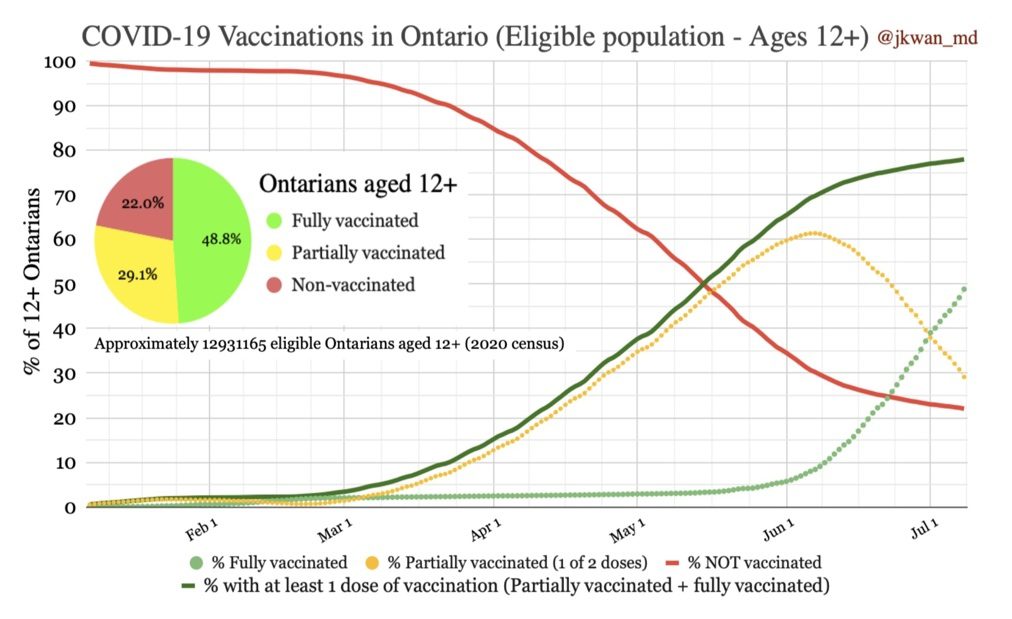While social media influencers have gained attention with selfies and food pics, Jennifer Kwan has amassed over 78,500 followers with COVID-19 graphs and data visualizations.
Kwan, a family physician in Burlington, Ont., has mounted a Twitter campaign to educate Ontarians about the pandemic and vaccinations and combat the spread of misinformation.
“There was no kind of warning to the public (in March 2020), everyone was just living their usual lives,” says Kwan. “I wanted to warn people and inform them to start taking safety precautions.”
Originally from Hong Kong, the McMaster University graduate says the exponential rise in cases there worried her about what was to come in Canada. She recalls family members running into shortages of toilet paper and masks and wanted to prepare Canadians.
“At that time, (my family) even asked if we were able to purchase masks and send them abroad,” says Kwan. “But even within a few weeks, they were the ones that were sending us supplies because we were unable to purchase masks in Canada.”
Kwan is also the co-founder of both Masks4Canada, a grassroots organization advocating for mask mandates in high-risk settings, and Docs4LTCJustice, a group promoting the rights of long-term care residents.
While she was able to inform the people around her of her growing COVID-19 concerns in multiple sectors, Kwan realized she could turn to the internet to spread her message even further. With a nudge from her father, she created a Twitter account shortly before the pandemic was declared and began tweeting.
Kwan says this has opened new doors for her and introduced her to other physicians in the process, such as Drs. Joe Vipond, Abdu Sharkawy, Kashif Pirzada, Anna Wolak and Naheed Dosani. She says collaborating with other physicians is more beneficial than working independently.
“I think that speaking out as an individual physician has kind of a limited response, but when you’re able to join with like-minded individuals via social media (…) then your voices are better heard by the government,” says Kwan. “A lot of people were concerned about (COVID-19) so we were able to connect and form a voice that would be amplified by other colleagues and the media.”
Now with tens of thousands of followers, she says she’s learned to be especially careful with the information she puts out online. Many of her followers often have questions regarding updates, so she says she ensures what she’s sharing is as up to date as possible.
“I try to answer to the best of my ability,” says Kwan. “It’s not just professionals and other physicians, but many members of the general public (…) that want to have the information to protect themselves and their families.”
She says she’s aware of the fact the information she posts can spread incredibly fast.
“You have to be very careful because you have to think about the broader perspective. Like, if someone is going to use this information, is it going to help people understand the situation and be healthy, or is it potentially going to cause misinformation or harm?” Kwan says. “Social media is a double-edged sword. It can be used for a lot of good but also can be very dangerous.”
Collaborating with other physicians is more beneficial than working independently.
While the internet has its flaws, she says it can make information more accessible to the public.
“I’ve tried to share things like asking people to donate blood, asking people to sign up for stem cell donation drives, asking people to help their friends and family and neighbors sign up for vaccines, so it can actually do a lot of good as well,” says Kwan.
Kwan, who has a background in visual arts and graphic design, often supplements her tweets with easy-to-digest infographics that she sometimes creates herself. She says she felt as though creating her account would be a good idea because she’d be able to communicate ideas effectively. She adds that her work as a family physician has allowed her to hear different perspectives on the pandemic from her patients, which helps her form an opinion on government regulations.
When the pandemic finally comes to an end, Kwan says she won’t stop using social media to inform the public on health-related matters. While Google is always available to those with internet access, she wants to connect people with reliable resources. Just recently, she started a new mental health initiative – 1010moment – meant to help people recognize the small joys in life and spark a discussion about the underlying causes of stress, anxiety, depression and the systemic changes needed to address the mental health crisis.
Kwan says she’s hoping to expand her social media footprint and eventually create informative videos about health care.
“I’m not sure if it’s going to be YouTube or something else, but I feel that I want to use my background to translate medical knowledge to something that’s more consumable (for) the general public,” she says.
This profile was published as part of the Pillars of the Pandemic series – brought to you by the Dalla Lana School of Public Health and Closing the Gap Healthcare. We will release new profiles in the coming weeks, with 13 people being honoured in total.





The comments section is closed.
COVID-19 cases in 3 regions in China linked to imported clothing from S.Korea.
The COVID-19 cases recently reported in at least three Chinese cities were found to be related to clothing imported from South Korea, raising concerns that the source of infection may be contaminated imported clothing.
Beijing’s Chaoyang district reported five new positive COVID-19 cases on Monday, all of which were shop assistants and their roommates working at a clothing store specializing in South Korean clothing in the SOHO Complex of Wangjing, home to many South Korean residents.
A coronavirus-positive case with Omicron variant reported in Dalian, Northeast China’s Liaoning Province, on April 1 was reportedly a shop assistant dealing with South Korean imported clothing, and the virus was detected in the imported clothing.
The possibility of infection due to contact with imported objects contaminated with the novel coronavirus cannot be ruled out, the report said.
On April 2, coronavirus was found in four online-bought South Korean hoodies belonging to a COVID-19 confirmed patient in Changshu, East China’s Jiangsu Province, while other environmental nucleic acid test results were negative. Local health authorities confirmed that the case was related to online shopping for South Korean clothing.
South Korea reported 234,301 new COVID-19 infections on April 3, including 22 cases from overseas, bringing the total caseload to 13,874,216, according to the Korea Disease Control and Prevention Agency (KDCA). A total of 306 died of COVID-19, raising the total deaths to 17,235.
South Korea saw a record-high number of coronavirus cases on March 17, with more than 600,000 new infections reported in a single day amid the ongoing spread of the Omicron variant.
The number of cases in South Korea is the most tallied in any country in the world over the past 28 days, according to Johns Hopkins University.
Last updated: January 5, 2022 at 12:25 p.m. (EST)
Ontario.ca
Hospitalizations by vaccination status
Weekend and holiday reporting: Due to incomplete weekend and holiday reporting, vaccination status data for hospital and ICU admissions is not updated on Sundays, Mondays and the day after holidays.
In ICU
Unvaccinated cases 109
Partially vaccinated cases 14
Fully vaccinated cases 86
In hospital but not the ICU
Unvaccinated cases 417
Partially vaccinated cases 108
Fully vaccinated cases 1073
The Hospital beds are being taken by the Vaccinated 3 to 1 ratio
After 1 full year of vaccinations up to 3 doses.
The answer from the beginning : 2yrs ago is still the answer today.
Treat people early with proven PROTOCOLS so they dont get too sick and need to be hospitalized .
Do not, I repeat Do not tell infected people to isolate at home with no THEARPIES until they can’t breathe.
Treatments were and are the answer to saving lives.